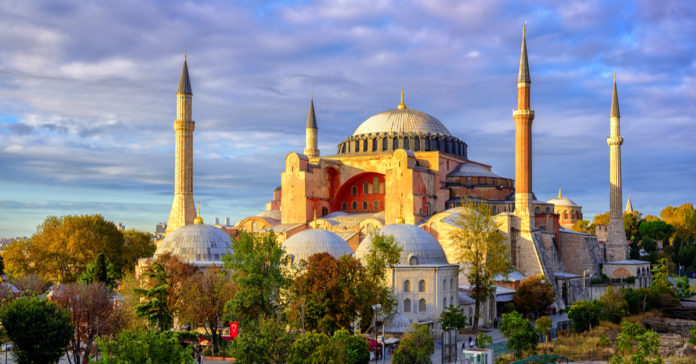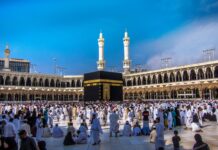Journalist Hafsa Kara-Mustapha says Western critics targeting President Erdogan over the Hagia Sophia decision should take a hard look in the mirror.
This week saw Turkey take centre stage in world affairs over a dispute concerning a church/mosque/museum conversion that had been dormant for the past 90 years.
Brought back to life by the very polarising Recep Tayeb Erdogan, Hagia Sophia, the once most prominent church of the Orthodox Christian faith, was turned into a mosque in the 15th century. It was then transformed into a museum in 1934 and is once again at the centre of Muslim-Christian relations since the Turkish leader decided to allow Muslim prayers to take place there.
This decision has united the various Christian denominations who’ve dismissed is as “unacceptable” and “provocative.”
Admittedly within the Muslim community itself opinions are divided. Some argue that it doesn’t foster healthy relations between the two great faiths while others insist it’s within Turkey’s sovereign right to return it to its mosque status.
But irrespective of where one stands on the issue, Erdogan has scored a major point in highlighting the ever existing double standards when it comes to anything relevant to Muslims and the Muslim world.
The Grand Mosque of Cordoba
Subscribe to our newsletter and stay updated on the latest news and updates from around the Muslim world!
There is no doubt Hagia Sophia has a major significance for Orthodox Christians but what about the Grand Mosque of Cordoba for Muslims, transformed into a church during the Spanish Reconquista?
The mosque is one of the most important monuments of early Islam and a mesmerising example of Arab-Islamic architecture. Its conversion from mosque to a church was not only offensive in terms of religious practice but a crime in light of the utter destruction carried out by Spanish rulers.
As time went on and its status as a church became entrenched, Muslims no longer made a claim to the building. However, in the early 2000s Spain’s increasing Muslim community tabled a request that would allow some worshippers to pray inside the large compound (able to accommodate around 30,000 worshippers) on Fridays.
But both Spanish authorities and the Vatican refused, barely causing a ripple in international media let alone the current outrage triggered by Turkey’s decision.
The Conquest of Constantinople
Back to Hagia Sophia. It’s worth remembering that Sultan Mehmet II bought the deeds to the church in 1453 from his own personal funds and consequently gifted it to the waqf.
Some would argue that the transaction was carried out under duress given that the Sultan had successfully conquered Constantinople and was now the all-powerful leader of the land. While there is merit to this interpretation, nothing forced Mehmet II to undergo these unnecessary theatrics.
At a time when Muslims were being violently purged from Spain during the ongoing Inquisition and Muslim buildings either destroyed or converted into churches, the Sultan’s decision to reciprocate in kind would have been welcomed by his subjects and understood by his foes.
Nevertheless, a formal contract was signed between the Patriarch of Constantinople and the new sovereign, marking it officially as a Muslim place of worship. While this agreement has been met with suspicion or even disdain, the Patriarch’s decision would have made sense.
Constantinople had been ransacked by Christian Crusaders coming from Rome and intent on recuperating lost funds during the first Crusades. The utter devastation unleashed on the city led many Byzantines of the time to consider the Muslim invaders as potentially better interlocutors then their Christian brethren.
By this time it was also well known that Christian communities of the Middle East had been butchered alongside Muslims by European fanatics intent on imposing their specific Christian creed. This in turn led most Christian communities of the Orient to favour Muslim leaderships over European Christian ones, which denied them their religious freedoms.
The Patriarch of Constantinople, aware of the brutality of his Roman counterparts no doubt believed that under Muslim rule the building (which had been destroyed) could thus be restored and maintained for posterity.
And while there is a rejection of iconography in Islamic practise, Byzantine icons have remained untouched inside the church despite its role as a fully functioning mosque for over 500 years – proof that its Christian past had been respected.
Selective outrage
Today those commentators quick to dismiss any religious practise as “fairy tales” and who’ve been instrumental in destroying the fabric of Christian life and values in Western Europe, are now presenting themselves as the flag bearers of religious tolerance given that the guilty party is a Muslim.
But where is their outrage as BJP India continues to destroy ancient mosques, specific to Asian Islam, with total impunity?
Where are those advocates for interfaith relations when Muslims requested a one hour slot in the Mosque of Cordoba?
Last month Greece announced the closing down of the only Muslim prayer hall in Athens. Though the site was unlicensed as a place of worship, the capital’s Muslim community has been waiting for decades to obtain the rights to build a mosque to no avail.
Those nourished on a staple diet of Daily Mail and the Sun will be asking where are the churches in the Muslim world? Ignoring no doubt that the oldest Christian communities after Ethiopia exist in Muslim-majority nations and that the exodus of these Christians from their ancestral lands has been the result of the unholy wars unleashed on the Muslim world in the last century.
This story will eventually die out, after all none of Erdogan’s critics are in a position to lecture him on religious tolerance.
From Ivan the Terrible to Stalin’s treatment of the Tatars in Russia, from the endless wars of the 20th century started by the U.S. to France and Britain’s heinous colonial legacy, this cacophony resonates like another story designed to inflame patriotic sentiments amongst those who’ve resorted to crude populism on which to build their careers.
Meanwhile Hagia Sophia has entered its 16th century. Here’s to 16 more.






















